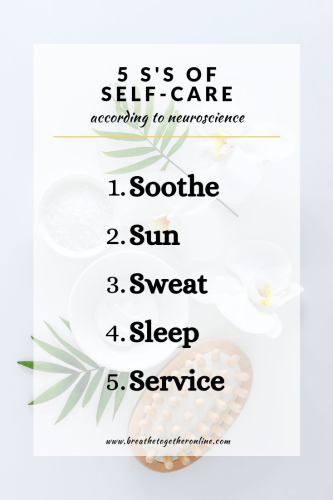It’s tough to not be revved up about what’s happening in the world today. Some days, it might feel hard to be optimally loving and kind, to keep our emotional center “in check” in a way that feels most harmonious. It’s on those particular days that I have to remind myself to be conscious and clear about what actions I take (or choose not to take). Sometimes, just saying to myself, “You may be right” is the best way to not get hooked into a crazy debate with someone who only wants a fight. It’s my job to keep myself healthy and sane, and emotions don’t typically facilitate making clear and sane decisions.
I learned about the self-care hacks from health psychologist and popular lecturer at Stanford University, Kelly McGonigal. These “5 S’s of self-care” are a neuroscience-based set of recommendations helps identify the key ways that your parasympathetic nervous system can be calmed, thereby facilitating the mind to operate from a place of “pause and plan” versus “fight or flight.” These steps can be used anytime the amygdala (emotion-center of the brain) gets high-jacked by frustration, anger, doubt, fear, or general lack of patience. In fact, this can be seen on MRIs; neuroscience advancements have shown how the executive decision-making center of the brain called the prefrontal cortex, can lose its ability to function if these negative emotions create cortisol and adrenaline that pulse through the body. Instead of making decisions from a neutral state, our words, actions, and behaviors are typically reactive in nature and not responsive to the actual situation at hand. Moreover, damage from these reactive behaviors can lose trust and create high levels of tension in relationships. Communication suffers, stress levels rise, and personal health and well-being are greatly sacrificed.
So, what to do?
Follow these simple neuroscience-based recommendations to lower cortisol in the body and generate “good” chemicals, such as dopamine, serotonin, and oxytocin. This will allow you to respond from a place of pride, confidence, and better connection in your relationships.
Neuroscience-Based 5 S’s of Self-Care to mitigate the amygdala high-jack:
- S1: Soothe – Know the methods that best soothe your nerves. Engage in practices that decrease your setpoint for triggering anger or frustration. Examples include meditation, yoga, nature walks, baths, listening to music, and any activity that puts you back into a state of flow.
- S2: Sun – Being outside, especially on a beautiful day, soaking up vitamin D, helps to mitigate catastrophizing (the sense that our problems are the worst or most harmful thing we’ve ever experienced). We gain perspective for better problem-solving. Clarity is present when we’re tapped into the rhythms of nature, and we don’t feel separate from one another, rather, we feel a part of a bigger experience.
- S3: Sweat – Once adrenaline and cortisol have been created, it’s important to work them out of the system. The basic rule of thumb is that after a stressful encounter, it takes only six seconds for cortisol to start pulsing, where it then stays in the system for at least one hour after. There’s not a lot of time to interrupt this cycle. Truly, “sweating it out” helps lower cortisol and creates dopamine, providing an immediate sense of reward. Sweating is a great way to release stress hormones once they’ve been created.
- S4: Sleep – Getting sufficient nightly sleep is important. Most scientists agree that adults need about seven to eight hours of solid sleep during the evenings, and sometimes more depending on age and level of activity (physically, mentally, or emotionally). In order for brain neurons to fire and wire effectively, it’s important to get enough deep sleep REMs (typically three to four hours). Sleep deprivation is a known cause of accidents, technical mistakes, and shortens the emotional fuse. During the day, if you get easily exhausted, naps are known to recharge the brain, even if only for a brief 15 to 20 minutes. You might even consider looking at your pre-bedtime routines and create more conscious ways to turn off electronics and your “gotta do, do, do” brain at least an hour before bedtime.
- S5: Service – The “mac daddy” of the 5 S’s is helping another person or animal. When we serve another, we get out of our own problems or issues and act from a place of deeper purpose and connection. In turn, oxytocin, the brain chemical of connection and belonging, gets released in the system. This positive release can give us the confidence to want to work with another person, build trust, have a conversation that is really important but might feel really difficult, and restore faith. When it’s important to invite collaboration and care, do more service!
For more information on the impact of stress hormones such as adrenaline and cortisol, as well as the reward chemical of dopamine, and the brain chemicals of serotonin and oxytocin, check out Simon Sinek’s research, nicely compiled in his book “Leaders Eat Last.” The next time you find yourself getting emotionally charged, try one of these brain hacks and start to notice what works best for you. Get into the daily habit of treating your inner system with love and care, and see how that translates into more love and care in your external world.
















